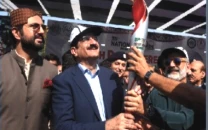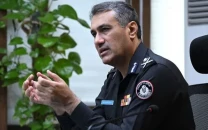Medical technique: How to save a life? CPR!
Tabba Heart Institute hopes to train people once a month and spread the word.

It was just another morning at the Khan household where 45-year-old Farah collapsed in the middle of a conversation with her mother-in-law. The confused mother-in-law rushed Farah to hospital wondering what had happened, as she had no medical history of heart-related problems, blood pressure or diabetes. The emergency staff refused, however, to admit her and instead referred them to a specialised heart centre. Farah did not survive long enough to receive medical care and was declared dead on arrival.
It would be incorrect to suggest that Cardiopulmonary Resuscitation (CPR) could have saved Farah’s life. Nonetheless, doctors strongly believe that for people in a similar situation, CPR gives them a fighting chance. Thus, the Tabba Heart Institute (THI) held a community seminar to train 20 people on how to administer CPR. But much more public awareness needs to be spread on basic life support and the ability to perform CPR. During the four-hour session the participants were trained in CPR for infants and adults and the THI hopes to hold similar sessions at least once a month. THI consultant cardiologist Dr Kaleemullah Shaikh explained the procedure in six easy steps.
How to administer CPR in adults
Step 1: Check for unresponsiveness. This involves tapping the person or shrugging their shoulders to check for movement. If there is no physical movement, try to get a verbal response from them. E.g. “Are you OK?”
Step 2: Call for help. If there is another person in the room ask them to call for medical help or assistance.
Step 3: Check for a pulse. This can be done by taking the index and middle finger and placing them at the centre of the neck, right under the person’s chin. Once positioned on the neck, slide your finger either to the right or left to place it under the jaw. A beating sensation will let you know if there is a pulse.
Step 4: Administer CPR. Take your dominant hand and interlock it with your other hand on top. Place the heel of your hand where the rib cage ends. Use the heel of your hand to pump the compressions. The chest must be compressed to about two inches while ensuring that too much pressure is not exerted and damages the rib rage. Doctors say 30 compressions in less than 18 seconds should be administered. It is important to keep note of whether the person’s chest is expanding during compressions and keep a count of administering about 100 compressions per minute.
Step 5: Check airway. Tilt the person’s head backward and lift their chin. This helps align their airway. After the first 18 compressions have been administered two ‘rescue breaths’ should be exhaled into the person, a second or two apart. If there is still no response start the procedure again.
Step 6: If after two minutes the person has not revived check their pulse again and re-evaluate whether or not to administer CPR again.
According to Shaikh, there are three reasons to stop administering CPR. First, if the patient has revived, second when hospital personnel arrive and third when the person administering CPR is exhausted. He went on to explain, “With every minute that goes by you lose a 10 per cent chance of reviving a person.” Therefore in about 10 minutes you probably lose all possibility of successfully resuscitating a person from cardiac arrest. However, there are exceptional cases such as those people suffering from hypothermia where CPR can continue for hours.
Published in The Express Tribune, June 19th, 2011.


















COMMENTS
Comments are moderated and generally will be posted if they are on-topic and not abusive.
For more information, please see our Comments FAQ